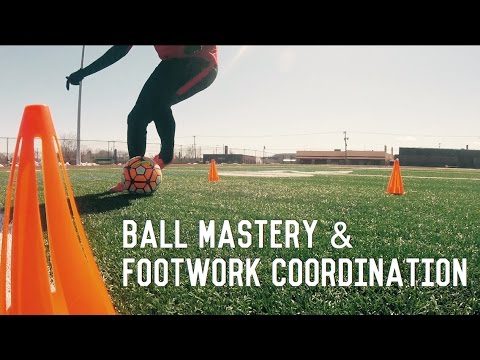In the exhilarating world of football, the final third is where dreams are realized and matches are won. It is here that speed and coordination become paramount, as players strive to outmaneuver their opponents and seize every scoring opportunity. The ability to swiftly navigate through tight spaces, deliver precise passes, and execute lightning-fast shots can truly make the difference between victory and defeat. Join us as we delve into the art of speed and coordination in the final third, exploring the techniques and strategies that separate the best from the rest on the pitch.
Advantages
- Increased Goal-Scoring Opportunities: Speed and coordination in the final third of the field allow teams to quickly transition from defense to attack, creating more opportunities to score goals. Players who can move swiftly and work together effectively in the attacking zone can catch opponents off guard and create openings to take shots on goal.
- Enhanced Counter-Attacking Ability: With speed and coordination, teams can launch quick counter-attacks from their defensive zone to the opponent’s final third. The ability to rapidly move the ball forward and coordinate their movements allows teams to exploit spaces left by the opposition, catching them off balance and increasing the likelihood of scoring goals during counter-attacks.
- Improved Ball Retention: Speed and coordination play a vital role in maintaining possession of the ball in the final third. Players who can quickly pass and move into open spaces can create passing triangles, making it challenging for the opposition to regain possession. This advantage allows teams to sustain pressure on their opponents and create more scoring opportunities.
- Effective Combination Play: Speed and coordination enable players to combine their skills and execute intricate passing combinations in the final third. Quick one-two passes, overlapping runs, and well-timed through balls become possible with a high level of coordination and speed. This advantage can lead to destabilizing the opponent’s defense, creating openings for players to exploit and score goals.
Disadvantages
- Lack of Goal-scoring Opportunities: Ineffective speed and coordination in the final third can result in a limited number of clear chances to score goals. This can greatly reduce a team’s ability to win matches and achieve their objectives.
- Difficulty in Breaking Down Defenses: Without proper speed and coordination in the final third, teams can struggle to break down well-organized defenses. This can lead to a lack of creativity and unpredictability in their attacking play, making it easier for opponents to defend against them.
- Inefficient Counter-Attacking: Speed and coordination are crucial in executing successful counter-attacks. If a team lacks these qualities in the final third, they may struggle to transition quickly from defense to attack, missing out on potential scoring opportunities and allowing opponents to recover and regroup.
- Vulnerability to Counter-Attacks: In the absence of effective speed and coordination, teams may leave themselves exposed to counter-attacks from their opponents. This can lead to conceding goals and ultimately losing matches, as the team may struggle to recover defensively if their attacking moves break down.
- Difficulty in Creating Space: Speed and coordination play a vital role in creating space in the final third. Without these qualities, teams may find it challenging to create gaps in the opposition’s defense, making it harder to find passing lanes or create scoring chances for their forwards.
What is the importance of coordination in football?
Coordination is vital in football as it directly impacts the overall performance of the team. Without proper coordination, players’ skills become weaker, resulting in poorer passing techniques, slower change of direction, and subpar body-on-body performances. A lack of coordination can hinder the fluidity and effectiveness of a team’s gameplay, ultimately hindering their chances of success on the field.
What does technical coordination entail?
Technical Coordination plays a vital role in facilitating an exchange platform that effectively aligns existing solutions with research needs. By gathering information about technology development roadmaps and collecting and comparing requirements from various user groups, Technical Coordination ensures that the right solutions are matched to meet specific research needs. With its ability to streamline and coordinate technical aspects, this function acts as a bridge, connecting disparate requirements and facilitating collaboration among stakeholders.
How can coordination problems be solved?
Coordination problems can be effectively resolved through clear communication and collaborative efforts. Firstly, establishing open lines of communication is crucial. This involves encouraging team members to express their thoughts, concerns, and ideas without fear of judgment. Regular team meetings and brainstorming sessions can facilitate this process. Secondly, fostering a collaborative environment is essential to fix coordination issues. Encouraging teamwork, cooperation, and mutual respect among team members can enhance coordination. This can be achieved by clearly defining roles and responsibilities, establishing shared goals, and promoting a culture of trust and accountability. By prioritizing communication and collaboration, coordination problems can be successfully overcome, leading to more efficient and productive outcomes.
In addition to communication and collaboration, employing effective project management strategies can also contribute to resolving coordination problems. Implementing a well-defined project plan with clear objectives and timelines can help streamline tasks and ensure everyone is on the same page. Moreover, assigning a dedicated project manager who is responsible for overseeing and coordinating various aspects of the project can enhance coordination. This individual can serve as a central point of contact, facilitating communication, tracking progress, and resolving conflicts. By combining strong communication, collaboration, and effective project management, coordination problems can be addressed, leading to smoother operations and improved overall performance.
Mastering the Art of Speed and Precision in the Final Third
In the exhilarating game of soccer, mastering the art of speed and precision in the final third is crucial for any aspiring player. The final third of the field is where games are won or lost, and it requires a unique set of skills to thrive in this high-pressure zone. One key aspect is speed, as players must be able to swiftly navigate through defenders and create scoring opportunities. Additionally, precision is paramount, as every pass and shot must be executed with the utmost accuracy. By honing these qualities, players can become formidable forces in the final third, capable of making the game-changing plays that propel their teams to victory.
To excel in the final third, players must possess the ability to seamlessly combine speed and precision. Speed allows them to outpace defenders and exploit gaps in the opposition’s defense, while precision ensures their passes and shots reach their intended targets. With lightning-fast footwork and explosive acceleration, players can leave defenders in their wake and create space for themselves and their teammates. By coupling this speed with precise passes and shots, they can unlock defenses and launch devastating attacks that lead to goals.
However, mastering speed and precision in the final third is not just about individual brilliance. It also requires a deep understanding of teamwork and communication. Players must anticipate their teammates’ movements and make split-second decisions to deliver the perfect pass or shot. This synergy between players is what separates a good team from a great one. By honing their speed, precision, and teamwork skills, players can elevate their game and become true masters of the final third, consistently delivering game-changing performances that leave opponents in awe.
In conclusion, the art of speed and precision in the final third is a vital skill set for any soccer player looking to make a lasting impact on the game. By combining lightning-fast speed with pinpoint accuracy, players can consistently create scoring opportunities and dominate their opponents. Furthermore, understanding the importance of teamwork and communication enhances their ability to execute these skills effectively. With these attributes in their arsenal, players can become unstoppable forces in the final third, leaving a lasting mark on the game and cementing their place as true masters of their craft.
Unleashing Explosive Speed and Pinpoint Accuracy in the Final Third
Unleashing Explosive Speed and Pinpoint Accuracy in the Final Third
In the fast-paced world of football, the ability to unleash explosive speed and maintain pinpoint accuracy is what sets the elite apart from the rest. In the final third of the pitch, where goals are made or missed, players must possess the agility to burst past defenders and the precision to deliver a deadly pass or strike. With lightning-quick footwork and a laser-like focus, these athletes navigate through a maze of opponents, leaving them in awe of their unmatched skill. Their blistering speed leaves defenders scrambling to keep up, while their accuracy ensures that every shot or pass finds its intended target. It is in the final third that the game is won or lost, and those who can combine explosive speed with pinpoint accuracy become the true masters of their craft.
In the fast-paced world of football, the ability to maintain speed and coordination in the final third is essential for any team aiming to secure victory. By seamlessly blending quick-thinking decision-making with precise execution, players can create opportunities and unlock the opponent’s defense. With every pass, dribble, and shot, the team’s collective effort in the final third determines the outcome of the match. Indeed, speed and coordination become the driving force that separates the champions from the rest, leaving spectators captivated and yearning for more exhilarating displays of skill and finesse.



